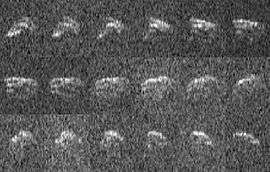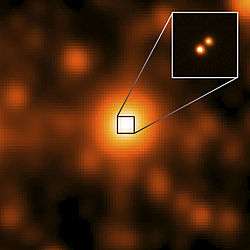2013 ET
2013 ET is a near-Earth asteroid that was first observed on March 3, 2013,[4] six days before its closest approach to Earth. It is estimated to be around 100 meters (330 feet) wide.[3][5]
 Radar imaging of 2013 ET | |
| Discovery[1] | |
|---|---|
| Discovered by | Catalina Sky Survey |
| Discovery site | Mount Lemmon Obs. (first observed only) |
| Discovery date | March 3, 2013 |
| Designations | |
| 2013 ET | |
| MPO 307059 | |
| NEO · Apollo | |
| Orbital characteristics[2] | |
| Epoch 4 September 2017 (JD 2458000.5) | |
| Uncertainty parameter 3[1] | |
| Observation arc | 6[1] d |
| Aphelion | 1.66881 AU (249.650 Gm) |
| Perihelion | 0.74239 AU (111.060 Gm) |
| 1.20560 AU (180.355 Gm) | |
| Eccentricity | 0.38421 |
| 1.32 yr (483.506 d) 1.32 yr | |
| 97.151° | |
| 0° 44m 39.048s /day[1] | |
| Inclination | 4.85153° |
| 171.316° | |
| 81.911° | |
| Earth MOID | 0.00375179 AU (561,260 km)[2] |
| Mercury MOID | 0.28725 AU (42,972,000 km)[1] |
| Physical characteristics | |
| Dimensions | 100 m (330 ft)[3] |
| 23.1[2] | |
Its closest approach to Earth was 0.0065207 AU (975,480 km; 606,140 mi) on March 9, 2013 at 12:09 UT.[2][6] The asteroid also makes close approaches to Mars and Venus.[2] The asteroid was imaged by Goldstone radar on March 10, 2013.[7]
2013 ET was one of four asteroids that passed in the vicinity of Earth during one week in early March 2013.[8] The other asteroids in this group besides 2013 ET, included 2013 EC, 2013 EC20, and 2013 EN20.[9]
See also
- List of asteroid close approaches to Earth in 2013
- 2013 EC
- 2013 PJ10
- List of asteroid close approaches to Earth
- List of Near-Earth asteroids by distance from Sun
- Near-Earth Asteroid Tracking
References
- "2013 ET". Minor Planet Center. Retrieved 21 August 2017.
- "(2013 ET)". JPL Small-Body Database. Jet Propulsion Laboratory. SPK-ID: 3629117. Retrieved 21 August 2017.
- Wall, Mike (5 March 2013). "Big Asteroid to Zoom By Earth This Weekend". Space.com.
- "MPEC 2013-E14 : 2013 ET". IAU Minor Planet Center. 4 March 2012. Retrieved 9 March 2012. (K13E00T)
- Dr. Lance A. M. Benner (7 March 2013). "2013 ET Goldstone Radar Observations Planning". NASA/JPL Asteroid Radar Research. Retrieved 9 March 2013.
- Gray, Melissa (7 March 2013). "Asteroid to fly past Earth this weekend". Light Years. CNN.
- DC Agle (18 March 2013). "Goldstone Radar Snags Images of Asteroid 2013 ET". NASA/JPL. Retrieved 19 March 2013.
- "Four Asteroids Buzz Earth in Single Week". Space.com. Retrieved 13 November 2018.
- "Four Asteroids Buzz Earth in Single Week". Space.com. Retrieved 13 November 2018.
This article is issued from Wikipedia. The text is licensed under Creative Commons - Attribution - Sharealike. Additional terms may apply for the media files.


